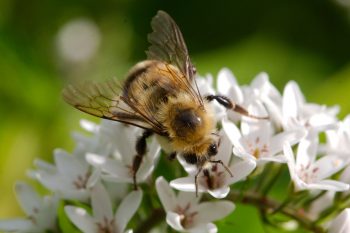The gooseneck loosestrife (Lysimachia clethroides) is in bloom and that generally means I have an opportunity to photograph common eastern bumblebees (Bombus impatiens) like this one. I don’t recommend planting loosestrife unless you really enjoy digging up plants where they appear throughout your garden. It can easily get ahead of you. We sometimes joke about planting two aggressive plants in a container and waiting to see which comes out on top. This has got to be a contender. It does have nice flowers, though, and its attractiveness to bees speaks well of it. Nevertheless, if I could get rid of all we had, I wouldn’t think twice about it.
Tagged With: Bombus impatiens
Eastern Bumblebee (Bombus impatiens)
Monarda, Asclepias, and a Bombus
Along our back fence, the garden has really gotten out of control. With the work we’ve been doing on our mom’s houses, we haven’t really had time to give it half the attention it needs and deserves. Consequently, it’s got goldenrod, poke weed, and thistles growing in abundance. Three of our planted perennials are doing quite well, however, including the bee balm (Monarda didyma, also known as Oswego tea or bergamot) and the butterfly weed (Asclepias tuberosa) shown here. The other, not yet in bloom, is obedient plant (Physostegia virginiana). All three are native to the area and extremely tough. The bees love them and I followed this common eastern bumble bee (Bombus impatiens) for a while as he moved from flower to flower.
Bumble Bee on Coneflower
The coneflowers (Echinacea purpurea) in our yard tend to get eaten up by insects of one sort or another. I’m not sure who the culprit actually is, but they eat holes in the ray florets (the petals around the central group of disc florets), making the flowers a bit less attractive for photography. The bees aren’t bothered, of course, and this bumble bee (Bombus impatiens). The generic name Echinacea comes from the Greek word meaning hedgehog or sea-urchin, which references the spiny center of the flower. The name Bombus for bumble bees comes from the Latin (which took it from the Greek) for “booming, buzzing, humming.”
Monarch and Bumblebee
I know I posted a photo of a monarch butterfly (Danaus plexippus) recently but I sort of like this photo of a monarch sharing a coneflower (Echinacea purpurea) with an eastern bumblebee (Bombus impatiens), so here you are. This was taken in the same garden as the former and like that one it was in the afternoon when the shade of the building was on it, so it isn’t as well lit as I would like.
I walked around the small pond next to my building and saw lots of raccoon footprints in the fresh mud. I took some pictures of those and also of some skippers, a cabbage white (Pieris rapae) and a pearl crescent (Phyciodes tharos).
Eastern Bumble Bee
I went out looking for pictures as usual this afternoon, when I got home from work. There is Campanula in bloom in the yard, and I took some pictures of those flowers. They don’t tend to come out the same color in photographs as they are in real life. Not entirely sure why. Then I moved over to the gooseneck loosestrife (Lysimachia clethroides), which is a real attraction to the bees. It’s quite invasive and I really would recommend against planting it in the strongest language, but if you already have it, you might as well enjoy the bees. There were a few honey bees but mostly it was the common eastern bumble bees (Bombus impatiens) that were moving quickly from flower to flower.
Bombus impatiens (Common Eastern Bumble Bee)
Who doesn’t love the humble bumble bee? They are everywhere and like many of us, they are not particularly flashy or flamboyant. Nevertheless, they busily go about their business. I like them quite a bit and enjoy watching them move from flower to flower. In this case, a common eastern bumble bee (Bombus impatiens) is on wingstem, also known as yellow ironweed (Verbesina alternifolia). There were also honey bees (Apis mellifera) and ailanthus webworm moths (Atteva aurea) on the same group of flowers. It had become quite hot again, with temperatures in the low 90s, and I’m starting to look forward to autumn.
Bumble Bee on Lavender
I sat in the middle of the front garden this afternoon and took a few pictures. There were some bumble bees (Bombus impatiens, the common eastern bumble bee) moving from flower to flower and I waited for one to land on the lavender (this is a variety of Spanish lavender, Lavandula stoechas called ‘Anouk Supreme’). I only got four photos and none of them are quite what I was hoping for but this one isn’t too bad. When I’m in the yard, especially when it’s hot, I generally favor the shade but if I’m looking for photos, especially insect photos, the sun is the place to be.







